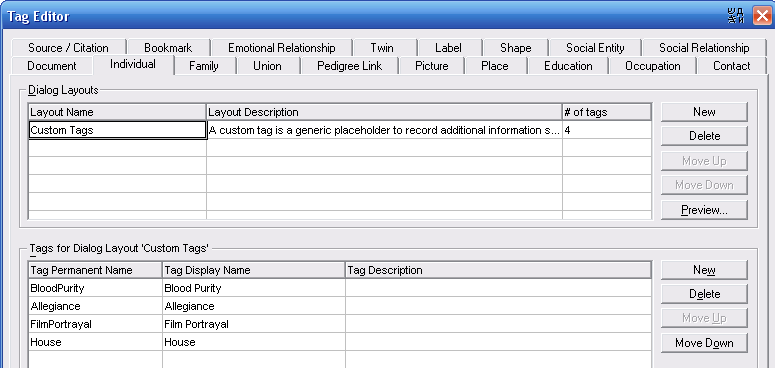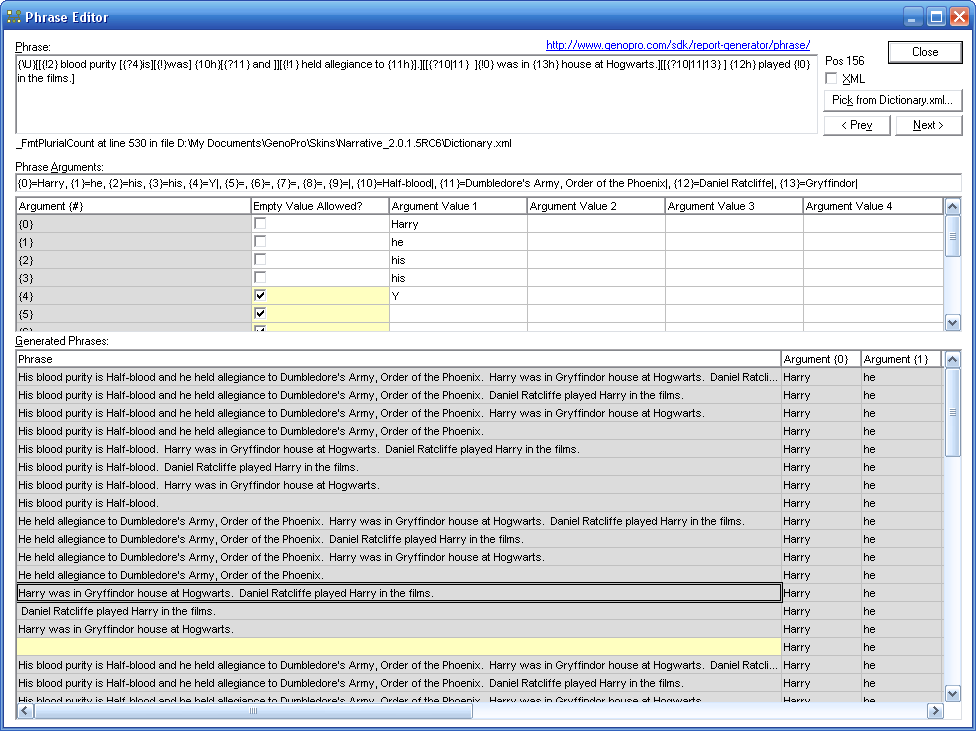|
Administrators
Customers
Important Contributors
FamilyTrees.GenoPro.com
GenoPro version: 3.1.0.1
Last Login: Yesterday @ 8:30 PM
Posts: 3,466,
Visits: 26,885
|
Options for customising the reports generated from GenoPro have been developed and extended over some considerable time. It has been difficult for the average user to find all the information required to enable them to customise their reports as they require. I am therefore attempting to put all the information in one place, namely the attached .gno file.
There are four basic mechanisms to help you customise your report without resorting to editing the scripts in a custom version of the Report skin.
- General appearance of HTML Narrative report. e..g changing background, fonts and colours. This is achieved using a custom HTML CSS 'stylesheet'. Knowledge of HTML styling is required here. The additional stylesheet is specified using a config parameter (see 4 below).
- Adding extra HTML code to the report pages. This can be achieved using 'Custom Markup tags' - a series of special codes and text you can add to data fields in your .gno file.
This is perhaps the most powerful way to customise your report. For example add an extra collapse/expand section to your report, adding Flash or mp4 video clips, extra images, directly inject HTML code, add new narrative phrases etc. See attached ,gno for full list and documentation. The '4. Examples' GenoMap in the report generated from this file illustrates most of the available tags. see http://familytrees.genopro.com/genome/CustomMarkupExample/default.htm
- Using Custom Tags in your .gno file to add extra detail and modify the behaviour of the script generating the report. You can group the tags into one or more 'Custom Tag Layouts'
All Custom Tags will be included in the Narrative and Descendants Reports unless the name starts with an underscore '_'. Alternatively you can exclude all Custom Tags in a particular Custom Tag Layout by prefixing the Layout Description with an underscore '_'.
By default your custom tag data items will be shown in a table in the Narrative Report, with a separate table for each layout. Column 1 holds the Tag display names and Column 2 the tag contents with one tag per row. Alternatively you can create a phrase template for each of your Custom Tag Layouts so that the data items are reported as a narrative phrase. These 'phrase templates' are constructed using GenoPro's phrase generator syntax and can be created and tested using the Phrase Editor on GenoPro's Tools menu.
The parameters 0-9 for the phrase are fixed as follows:
0=name, 1=Personal pronoun, 2=Relative Pronoun, 3=Objective pronoun, 4=Is Alive?/Is Extant/Are Together? 5=<, 6=>, 7=&, 8=', 9=" (params 5-9 allow html tags, attributes and entities within the phrase
Whilst parameters 10 onwards are the Custom Tag values in the order they are defined in the layout.
An example will make this clearer. The HarryPotter sample .gno included with GenoPro (under Help/Sample Files) has the following Custom Tags definition for Individuals

We can construct a sample phrase template:
{\U}[[{!2} blood purity [{?4}is][{!}was] {10h}[{?11} and ]][{!1} held allegiance to {11h}].][[{?10|11} ]{!0} was in {13h} house at Hogwarts.][[{?10|11|13} ]{12h} played {!0} in the films.]
N.B. The 'h' suffix is used on the custom tag arguments (e.g. 10h, 11h etc.) because their content is already HTML encoded.
This template could be stored in the Dictionary but an alternative is to store it in a Document Custom Tag. In either case the template is assigned a name consisting of the prefix PhCT_ followed by the layout name with spaces removed. So in this case the name is PhCT_CustomTags because the layout Name is Custom Tags.
To store in a Document Custom Tag first create a layout to hold all such tags. i.e. click Tools, Tag Editor and then click the Document tab. Add a new layout called say Custom Phrases and add a tag named PhCT_CustomTags. Enter a description of your choice. Click OK to close the dialog.
Now click File/Properties and you should see a new Custom Phrases tab. Click it and enter the template into the PhCT_CustomTags field.

We can then paste this phrase template into the phrase editor and test it by supplying values for each of the parameters (See Phrase Arguments). Note how the phrase editor tests every combination of optional parameters.

If we then generate the Report we see the phrase under Additional Information

- Amending configuration parameters. This can be done at the time the report is generated by displaying the 'View and Amend Configuration Parameters' dialog when prompted. Alternatively the required values can be preset in the Document Custom Tags in your .gno file.
The attached file has more documentation plus examples and all the Custom Tags used in the reports already defined and described and grouped into a 'Report Options' tab for each object type. Download the .gno file and use GenoPro 'Tools/Tag Editor' menu option to explore these. The Document Custom Tags are also defined and grouped under a separate tab for each report type. All Custom Tag definitions can be easily copied to your own .gno files. Open the attached .gno file for more information.
Update 2008/03/25 attached .gno updated
Update 2008/04/06 info re custom tag phrases added
Update 2008/04/18 attached .gno updated with JC's recommendations.
Update 2008/06/09 included Custom Msrkup documentation.
Update 2009/02/28 major revision of documentation in attached file and added moexamplesUpdate 2015/04/02 added movie mp4 to custom markup tags and minor edits to this post and documentation
'lego audio video erro ergo disco' or "I read, I listen, I watch, I make mistakes, therefore I learn"
 CustomReport.gno
(624 views,
18.37 KB)
Edited: Saturday, June 1, 2024 by
genome
CustomReport.gno
(624 views,
18.37 KB)
Edited: Saturday, June 1, 2024 by
genome
|